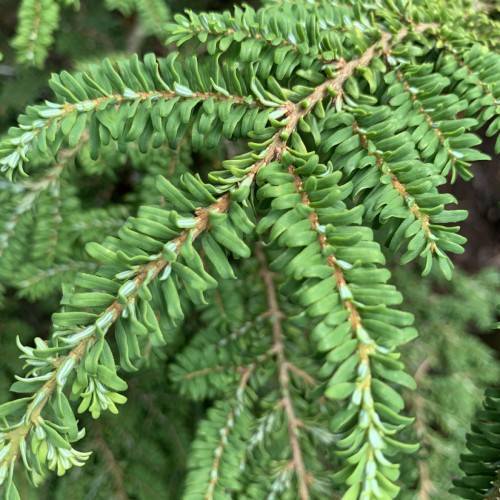
Canadian hemlock
Tsuga canadensis 'Curley'
Also Known As - eastern hemlockCycle:
Perennial
Watering:
Average
Hardiness Zone:
3 - 7
Flowers:
Flowers In Spring
Sun:
Deep shade, Filtered shade, Full sun only if soil kept moist, Part sun/part shade
Soil:
Sandy Loamy Clay
Cones:
Yes
Leaf:
Yes
Growth Rate:
Moderate
Maintenance:
Low
Care Level:
Medium
watering
Canadian Hemlock should be watered regularly. Its best to water thoroughly and deeply, allowing the water to reach the roots. This can be done by soaking the soil around the plant 1-2 times a week. During the summer months, water more frequently during extended dry spells. During the winter months, water less frequently, only providing water when the soil is dry. Canadian Hemlock prefers moderate to regular irrigation, so it should not be left in standing water or entirely dry for too long. Do not over-water as this can cause root rot or other water related issues.
sunlight
Canadian hemlock (Tsuga canadensis 'Curley') prefers full sun to partial shade, with 4 to 6 hours of direct sunlight each day. The amount of sunlight the plant receives depends greatly on geographic location and time of year. In northern parts of Canada, like Ontario and Quebec, Canadian hemlock will receive the most sunlight in the summer months, from June to September. During this time, the trees should receive at least 4 hours of direct sunlight per day (from 10 am to 2 pm being the best). In southern parts of Canada, like British Columbia, Canadian hemlock will usually receive the most sunlight in the spring months, from March to May. During spring, the trees should receive at least 4 hours of direct sunlight per day (from sunrise to 10 am being the best).
pruning
Pruning Canadian hemlock (Tsuga canadensis 'Curley') should be done in the late winter or early spring. For artistic pruning, dead or damaged branches should be removed as needed. An overall light pruning may also be carried out to remove suckers, remove any interfering branches, shape the plant and to thin out the density of the foliage. Pruning should be done gradually, removing no more than a third of the crown in any given season, and should be done with care to minimize injury to the plant. Pruning of the top of the plant should be avoided in order to keep its natural shape. An annual light pruning is usually adequate to keep Canadian hemlock looking healthy and attractive.
